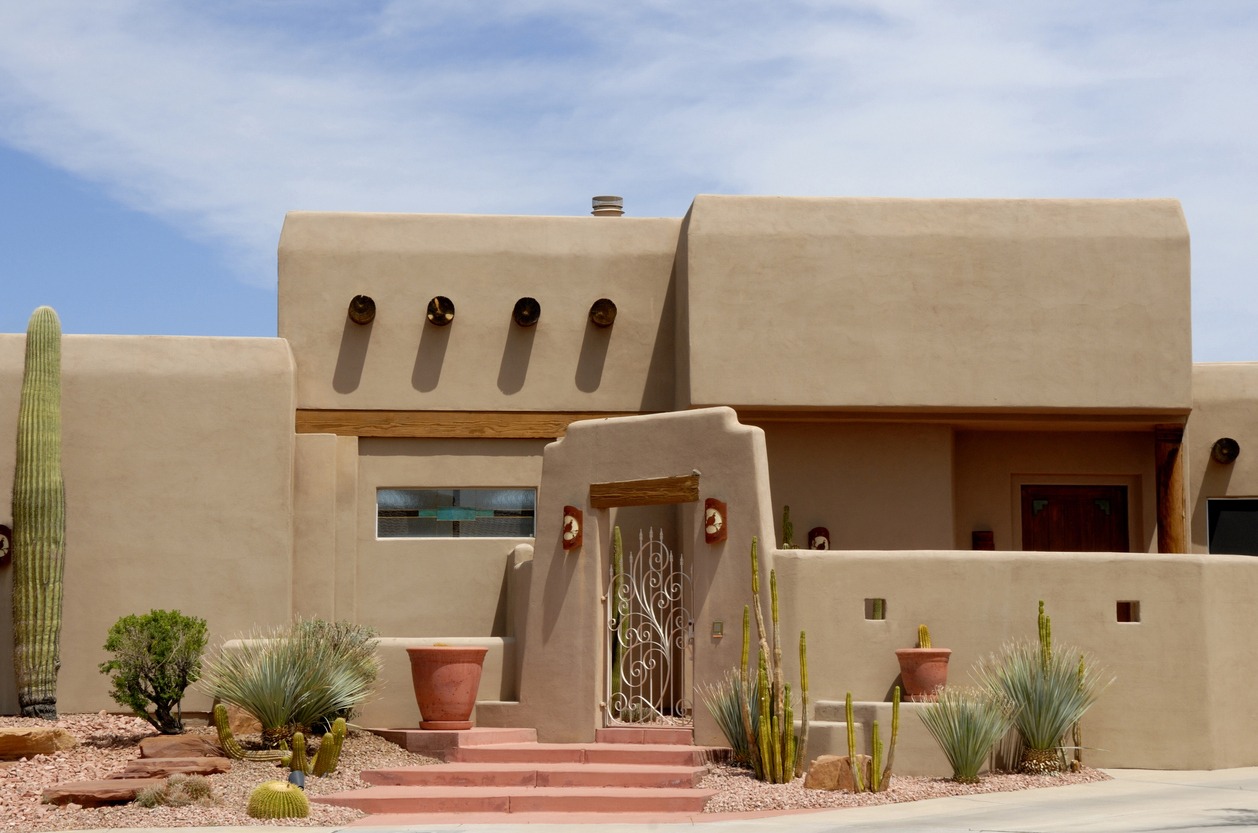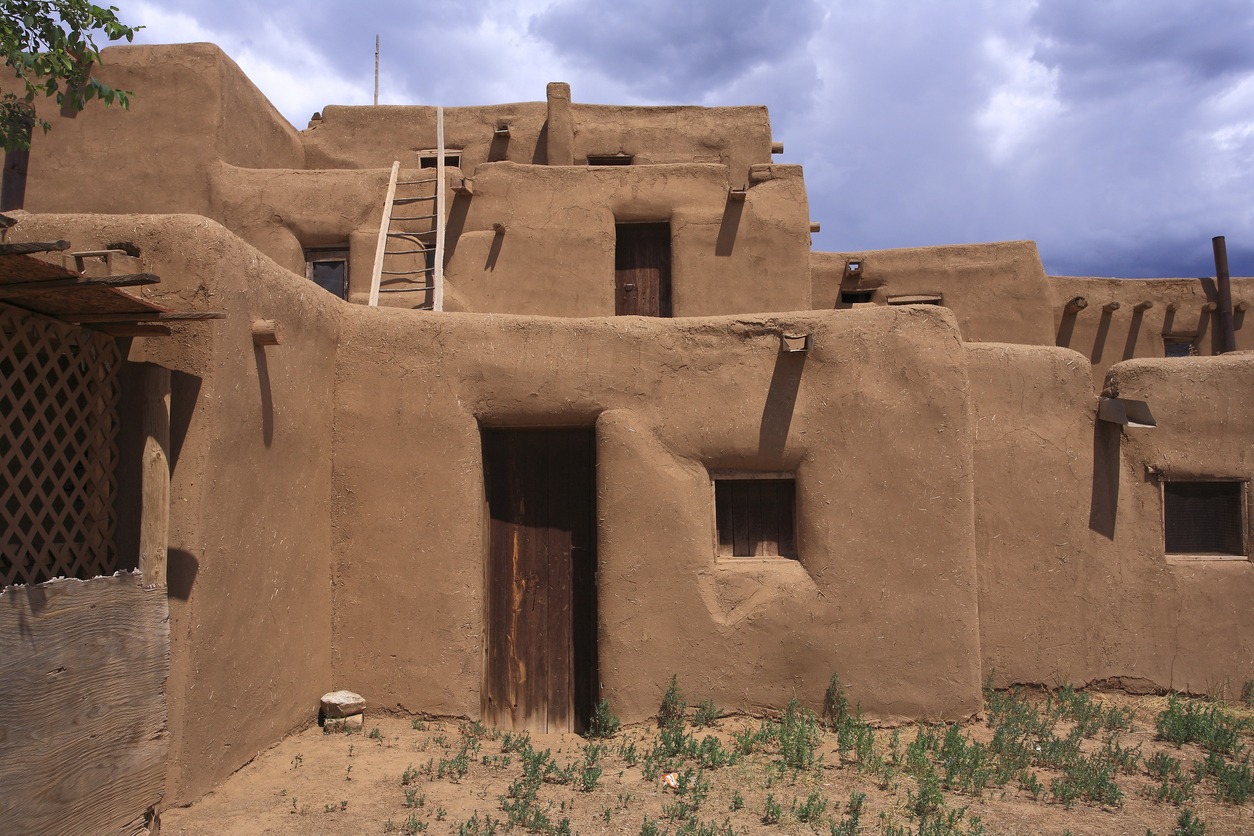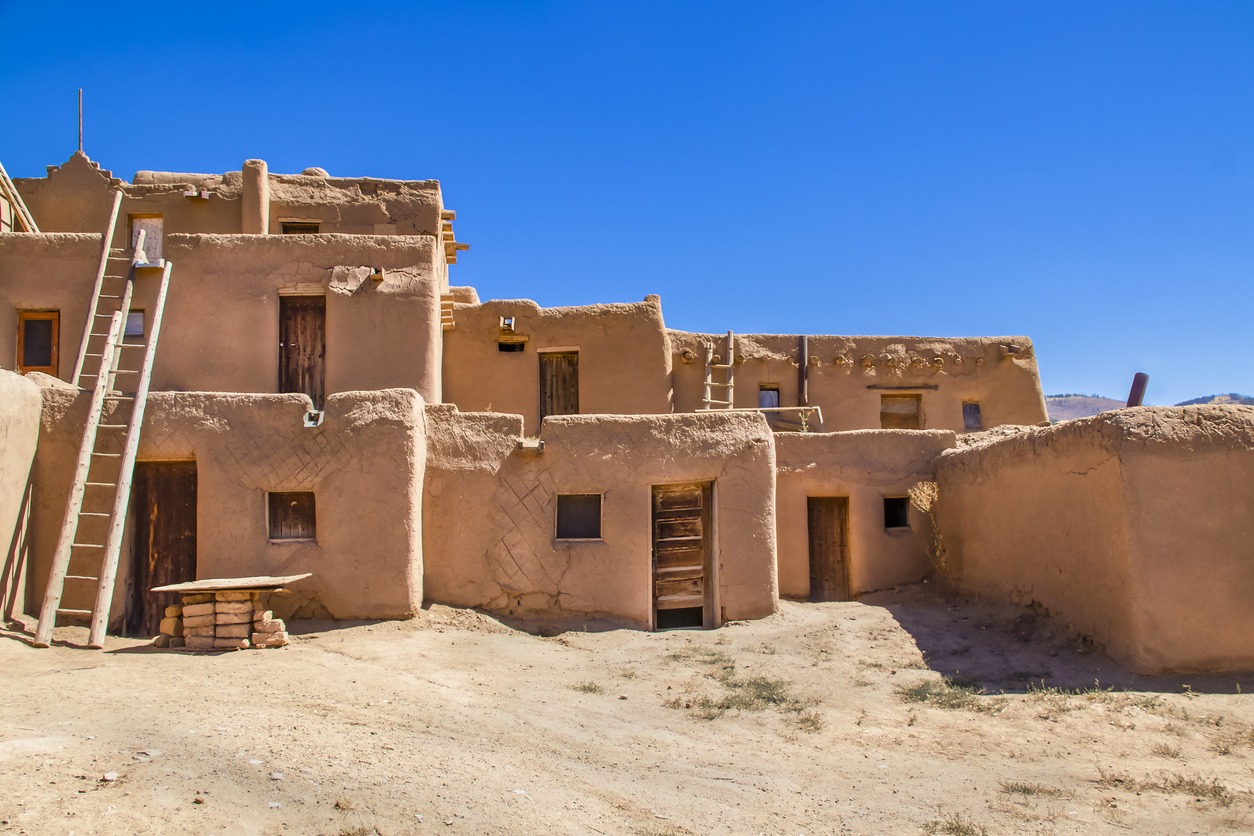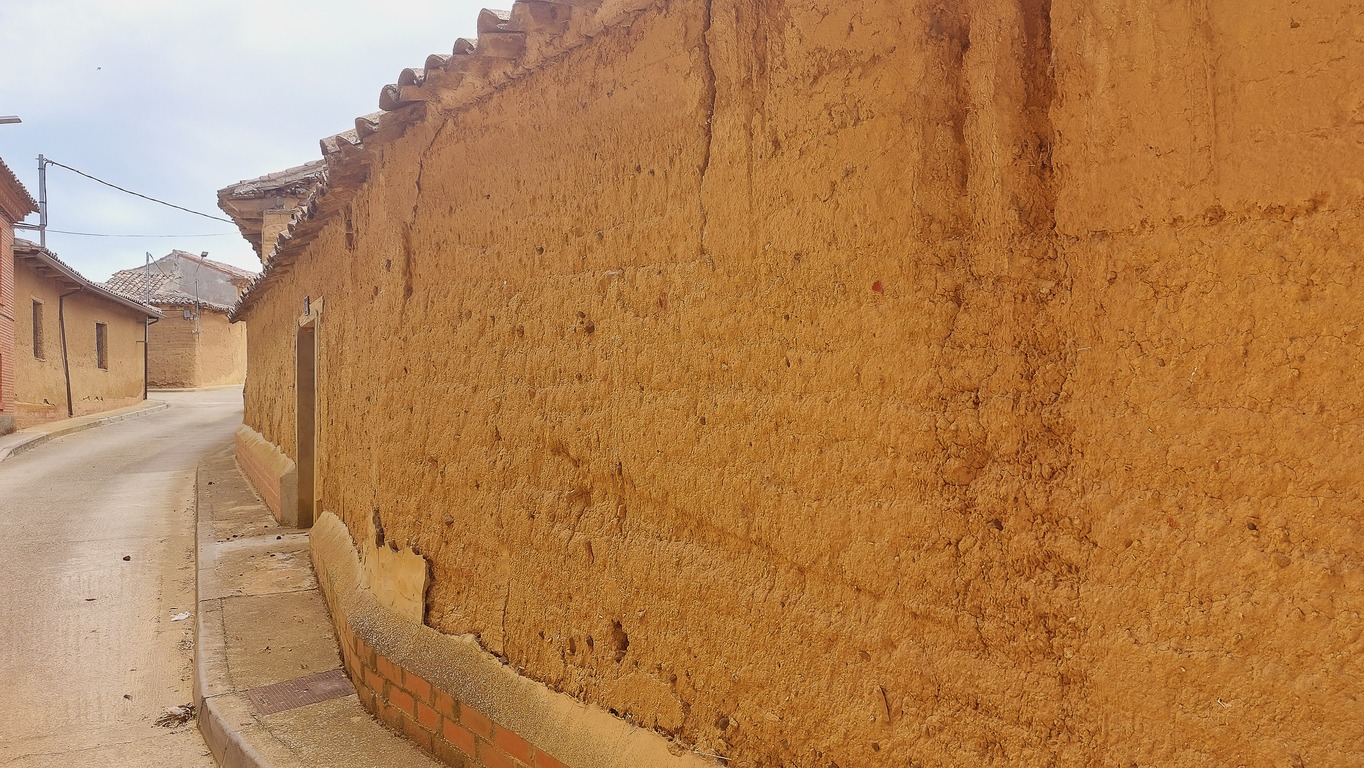Today, adobe is gaining popularity as an eco-friendly and affordable way to build. Many DIY enthusiasts and community groups are embracing adobe construction because it’s quite straightforward. Essentially, adobe is just sun-dried mud bricks, and what’s more abundant and budget-friendly than dirt and sunshine? Plus, as a bonus, adobe naturally keeps buildings cool in summer and warm in winter, reducing the need for air conditioning and heating.
But what exactly is it, and where did it originate? How is it constructed? Learn all about it in this article.
What Is Adobe?
At its core, “adobe” isn’t just an architectural style; it’s actually a building method. Though the term “adobe” is often used to describe a specific architectural style, it’s important to note that adobe is, in fact, a building material.
Adobe is fundamentally a type of dried mud brick created by combining natural elements: earth, water, and sunlight. It’s an age-old building material typically composed of densely packed sand, clay, and straw or grass mixed with moisture. These ingredients are shaped into bricks and left to naturally dry or bake in the sun without the need for an oven or kiln.
In some English-speaking regions with Spanish heritage, like the Southwestern United States, “adobe” is used broadly to refer to various types of earthen construction and architectural styles like Pueblo Revival or Territorial Revival. Most adobe buildings share similarities with cob and rammed earth structures. Adobe is one of the earliest building materials used worldwide.
Adobe bricks have been utilized across the globe, from the muddy riverbanks of ancient Egypt to the historic architecture of the Middle East. This ancient construction material has deep roots in arid regions, like the Native American Southwest and the Middle East. At the same time, the original process involved months of sun-drying. Modern versions that mimic its appearance are often kiln-dried and fortified with asphalt, lime, or cement to enhance durability and water resistance. This material has a rich history, and its construction methods and composition have evolved over time, shaped by climate, local customs, and historical eras.
The strength and resilience of adobe depend on its water content; excessive moisture weakens the bricks. Modern adobe may include an asphalt emulsion for waterproofing or a mixture of Portland cement and lime. In some parts of Latin America, fermented cactus juice is used for waterproofing.
While adobe itself is naturally unstable, adobe walls can be load-bearing, self-supporting, and energy-efficient. Adobe walls are often thick, providing natural insulation against environmental heat. Commercial adobe today may be kiln-dried, but traditional adobe bricks require about a month of sun-drying before use. Mechanically compressed adobe bricks, which need less moisture and can be used almost immediately, are also in use.
The adobe construction process leverages compressed earth to create low-energy, fire-resistant, biodegradable structures that can last for many years when constructed properly.
However, it’s crucial to choose the right location before you start building with adobe. Since adobe bricks aren’t fired but simply dried in the sun, they’re not extremely sturdy. They can shrink and swell with the weather. Here’s the catch: A very wet, flood-prone area might turn your bricks back into mud. Additionally, frequent freezing and thawing can cause them to crumble. That’s why adobe is mainly used in dry, mostly warm regions like the American Southwest, the Mediterranean, parts of Latin America, the Middle East, and arid areas of Africa and India. But with careful site selection and construction techniques, you can use adobe in wetter and colder places, too.
About the Word “Adobe”
In the United States, we say “ah-DOE-bee” when referring to adobe, placing the emphasis on the second syllable and pronouncing the final letter. Interestingly, unlike many architectural terms, adobe doesn’t trace its roots to Greece or Italy. It’s a Spanish word, but not one originating in Spain.
Actually, the word adobe has been around for about 4,000 years with minimal changes in pronunciation and meaning. Its origins can be traced back to the Middle Egyptian word “ḏbt,” meaning “mud brick” (with unwritten vowels). This Middle Egyptian term evolved into Late Egyptian and eventually into Coptic (around 600 BC).
This word was adopted into Arabic as الطوب “aṭ-ṭawbu” or “aṭ-ṭūbu,” with the definite article “al-” attached to the root “tuba.” It then made its way into Old Spanish in the 8th century C.E. as “adobe,” likely via Mozarabic. English borrowed the term from Spanish in the early 18th century, originally referring to mudbrick construction.
You’ll often hear this term used in the southwestern United States and Spanish-speaking countries. Just like the building material itself, the word adobe is ancient, with traces even found in ancient hieroglyphics.
In more modern English usage, the word “adobe” has expanded to encompass a style of architecture popular in the desert climates of North America, particularly in New Mexico, regardless of the construction method used.
History of Adobe
Adobe, one of the earliest materials humans used for building, traces its history back to around the eighth century B.C. The term “adobe” may be Spanish, but its roots can be found in an ancient Arabic word, either “al-tob” or “al-tub,” which simply means “brick.”
Some of the earliest known examples of adobe construction date back to around 8300 BC in what is now modern-day Turkey. Ancient Egyptians also used mud bricks for construction, and these mud bricks are considered precursors to adobe.
In North America, Native American tribes, particularly in the southwestern United States, were skilled in adobe construction long before the arrival of European settlers. They used adobe to build structures such as pit houses and cliff dwellings. Mesa Verde in Colorado is renowned for its well-preserved adobe cliff dwellings built by the Ancestral Puebloans (Anasazi).
The use of adobe construction expanded in warm, arid regions. It became prevalent in Spain and the broader Mediterranean areas. When the Spaniards arrived during the conquest of the Americas, they discovered that Native Americans were already skilled in its use.
This influence can be seen in the historic adobe architecture of the American Southwest. In the United States, you can find numerous examples of historic adobe architecture, particularly in Southern California and the southwestern states. Santa Fe, New Mexico, boasts many adobe structures, including the Palace of the Governors, which dates back to the early 17th century. Another gem is the Historic Taos Inn, also in New Mexico, featuring several adobe houses from the 1800s. A must-see for tourists is the San Francisco de Assisi Mission Church in Rancho de Taos.
Adobe construction techniques spread to various parts of the world with arid or semi-arid climates. It became a prominent building method in regions of the Middle East, North Africa, Latin America, and even parts of India. Local variations in adobe construction techniques developed, influenced by climate, available materials, and cultural preferences.
Perhaps the most famous adobe structure, and certainly the largest in the world, is the Great Mosque of Djenné in central Mali, near the Sahara Desert’s edge. Constructed in 1907 atop the remnants of earlier mosques, this mosque boasts walls as thick as 24 inches (61 centimeters) and arches that reach heights of 45 feet (13.7 meters), covering an impressive 62,500 square feet (5,806 square meters). Djenné, once a hub of learning and trade, saw wealthy merchants constructing elaborate houses from the readily available mud along the creeks leading to the Bani River. The town was strategically built on hills to safeguard against river floods, and many of these historic houses still stand today.
In recent years, there has been a resurgence of interest in adobe as a sustainable building material. Architects and builders are exploring modern techniques to enhance the durability and energy efficiency of adobe structures. Adobe is also used in eco-friendly and “green” building practices due to its natural and locally available ingredients.
In addition to its use as a building material, “adobe” has come to refer to a style of architecture characterized by its use of earthen materials and its integration with the natural environment. This architectural style is particularly popular in desert climates, such as the American Southwest and parts of Mexico.
How are Adobe Bricks Made?
Much of the adobe construction process remains rooted in practices dating back over 3,000 years. While modern variations exist, many builders adhere to traditional methods to maintain the distinctive appearance and texture of adobe structures.
Here’s a step-by-step look at how adobe bricks are made:
- Mixing the Ingredients: Sand and clay are blended with water to create a mud mixture. Often, straw or grass (and sometimes even manure) is added. This addition aids in achieving uniform brick shapes as the mud dries.
- Forming the Bricks: The mud mixture is placed into wooden molds and manually leveled. These molds can produce bricks of various sizes and shapes, ensuring flexibility in design.
- Drying in the Sun: After molding, the bricks are carefully removed and laid on a surface covered with straw or grass. They are left to air-dry in the sun for several days.
- Air-Drying: Following initial drying, the bricks are positioned on their edges and left for at least four weeks of air-drying. This process ensures that the bricks harden and become suitable for construction.
Building with adobe bricks involves several key steps:
Laying the Foundation
Adobe houses typically lack basements and instead have foundations made from locally available materials like stone or masonry red brick.
Laying the Bricks
Once the foundation is set, builders create the adobe walls by stacking earthen bricks on top of each other. Adobe bricks are laid using mud mortar, as it allows for expansion and contraction along with the bricks. Cement or other rigid mortars are not recommended.
Building Thick Walls for Strength
Adobe walls are constructed to be thick, often exceeding 10 inches, providing strength and helping to regulate the temperature inside the house. When laying adobe bricks in staggered courses, use mortar that matches the bricks’ composition and color. For added strength and resistance to lateral forces and cracking, reinforce the adobe walls with vertical and horizontal elements such as wood, bamboo, steel, or mesh.
Creating Openings for Doors and Windows
While keeping openings to a minimum to maintain structural integrity, builders incorporate wooden lintels for support.
Adding Roofing
Roofing materials vary based on location and preference, with options ranging from thatched roofs to terra cotta tiles or modern choices like wooden shingles and metal roofing. Roof framing should consider wind and snow loads, insulation, and ventilation.
Finishing with Protective Coatings
The adobe walls are typically finished with protective coatings such as mud plaster, lime plaster, whitewash, or cement stucco. These coatings not only enhance appearance but also help regulate humidity and reduce erosion, contributing to the longevity and beauty of the structure.
Different Adobe Wall Building Techniques
There are three primary bricklaying techniques for constructing walls:
1. Stretcher Technique
Bricks are laid longitudinally, exposing only the stretcher side of the brick. This results in a thinner wall, suitable for interior dividing walls.
2. Header Technique
Bricks are laid to expose the width side or “header.” This results in a wall as wide as the length of the bricks and is often used for load-bearing structures or exterior walls with good thermal properties.
3. Hollow Technique
Four bricks are laid to form a square-shaped “hollow” space between them, and every fifth set of bricks uses a “header” technique for pressure and seismic reinforcement. This technique can create an air chamber filled with materials like volcanic sand or sawdust to enhance thermal insulation, making it suitable for cold climates. It’s particularly effective for circular structures and can save resources and money when used correctly.
In terms of seismic resistance, reinforcing the vacant space between bricks in vertical walls increases flexibility and resistance, making this technique a solid choice for earthquake-prone areas.
To create curved walls, it’s crucial to understand the geometry of shapes like spirals, circles, ovals, and ellipses. A plumb line can help maintain straight walls, ensuring proper mechanical and seismic resistance.
Benefits of Adobe
There’s a rising interest in new adobe construction, particularly in the American Southwest. Why? Well, adobe bricks are made from dirt and dried naturally under the sun and air. This makes them an affordable and eco-friendly building material that’s gaining traction.
Adobe construction appeals to individuals and organizations focused on affordable, eco-conscious housing. Here are some key advantages of adobe construction:
- Renewable: You can find dirt almost anywhere, so the raw material is abundant and renewable.
- Local: There’s no need to transport materials over long distances; it’s all readily available nearby.
- Cost-Effective: Adobe is budget-friendly, making it an attractive option for those with limited resources.
- Healthy: Unlike some modern materials, adobe doesn’t release harmful chemicals, contributing to healthier living spaces.
- Energy-Efficient: Thick adobe walls have excellent thermal mass properties. They absorb heat from the sun during the day and release it slowly at night, assisting with natural cooling in summer and heating in winter.
- DIY-Friendly: Many people can learn to construct with adobe bricks themselves, making it accessible for DIY enthusiasts and volunteer groups building homes for others.
- Durable: With proper maintenance, an adobe structure can stand for centuries.
Environmental Benefits of Adobe Construction:
Adobe construction has several environmental benefits:
- Thermal Mass: Adobe’s high thermal mass allows it to absorb heat during the day and release it slowly at night, reducing energy consumption in hot, dry climates.
- Low Waste: Adobe bricks produce minimal waste, with zero hazardous waste. They have a small environmental footprint due to local material use, reducing transportation energy.
- Sound Insulation: Adobe offers low sound transmission, contributing to a peaceful living environment.
- Customization: Adobe construction allows for customizable designs, minimizing the need for expensive construction equipment.
While adobe has become popular for its sustainability and conservation benefits, it’s essential to consider location and maintenance for long-term stability. Its environmental efficiencies make it an excellent choice for dry climates.
Variations in Adobe Architecture
In the beginning, adobe homes were typically circular and often partially submerged underground. Over time, they evolved into the rectangular shape we commonly see today. As settlers started blending different architectural influences into adobe-style houses, they gave rise to Pueblo houses. These often incorporate additional materials like cement or asphalt for reinforcement.
Here are the different variations in adobe architecture:
Pueblo Style and Pueblo Revival
Adobe construction is closely linked to Pueblo architecture. Spanish settlers merged their architectural knowledge with the terraced communities of indigenous people, leading to the Pueblo style we know today.
The Pueblo style eventually transformed into the Pueblo Revival house, characterized by the use of a more contemporary timber frame. Pueblo Revival homes may feature architectural elements such as slanted roofs, but they maintain earthen materials on the exterior to harmonize with traditional adobe-style homes.
Monterey Style and Monterey Revival
In the early 1800s, Monterey, California, was a significant seaport. New Englanders moving west combined their home design ideas with local adobe construction customs. Thomas Oliver Larkin’s 1835 home in Monterey set the standard for the Monterey Colonial Style, demonstrating how architecture often blends features from diverse origins.
Mission and Mission Revival
Spanish colonization in the Americas brought the Roman Catholic religion, and Catholic-built “missions” became symbols of this new world. Mission San Xavier Del Bac near Tucson, Arizona, constructed in the 18th century, showcases original adobe brick repaired with low-fired clay brick.
Spanish Colonial and Spanish Colonial Revival
While Spanish-style homes in the New World don’t always use adobe, true Spanish colonial homes were constructed during the extensive Spanish occupation from the 16th to 19th centuries. Homes built in the 20th and 21st centuries “revive” the Spanish homeland’s architectural style.
However, the traditional construction of houses in medieval Calatañazor, Spain, illustrates how this building method transitioned from Europe to America, featuring a stone foundation, overhanging roof, timber beams for support, and adobe bricks—all concealed by a defining surface coating that characterizes the architectural style. For more information on the origins and evolution of the adobe homes, check out the History of the Adobe House.
Conclusion
Adobe has played a pivotal role in construction for over 5,000 years. Presently, it is experiencing a resurgence due to its environmental and economic advantages. In many respects, the use of adobe to shape our living environments brings humanity together across eras and regions. By embracing it, we not only reconnect with our historical foundations but also lay the groundwork for the future.
Today, outdated biases against building with earth and clay are giving way to innovative techniques that provide both ecological and financial benefits, ultimately transcending the boundaries of time, space, and culture.




